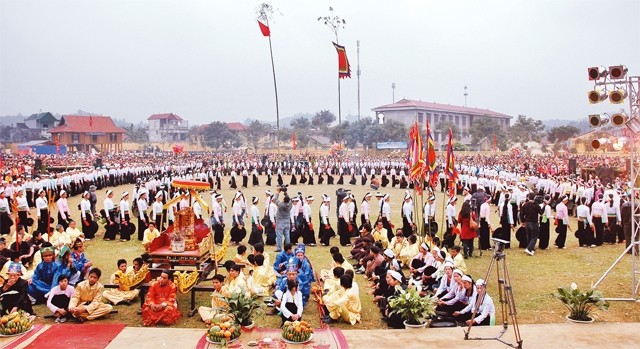Mo Muong—Epic of the Muong people
Mo Muong is a tradition of epic poetry passed down through generations of the Muong people. It is important in family life, as well as in community life. The main authority in mo Muong is the tluong (“shaman”), who has committed to memory tens of thousands of lines of Muong oral mythology and is expert in traditional rituals and ceremonials. The tluong commands considerable prestige in the Muong community.
Surveys have shown that mo Muong recitations are widely used in 23 of the Muong people’s rituals. One of the rituals that fully represent the essence and core values of the mo tradition is the Muong funeral, where tens of thousands of mo lines are recited throughout twelve days and nights. The lines are divided into cat or roong (“chapters”) with each chapter having a specific topic and purpose for each stage of the ceremony.
According to Bui Van Noi, a researcher of folkloric culture, mo Muong is an epic revived for use in Muong people’s funerals, endowing Muong deaths with a poetic significance.
A number of versions of mo have been recorded in Hoa Binh Province. Bui Thien, a collector of information on folkloric culture,has said that it takes 23 days to fully recite mo Muong, which includes 115 chapters and over 44,000 lines.
Over 22,000 other mo lines have also been recorded in the three-volume research of Bui Van Noi, while the book Mo Muong Hoa Binh, published by the Hoa Binh Province People’s Committee in 2010, listed over 22,500 lines.
Mo Muong is a unique piece of cultural heritage reflecting the Muong people’s outlook on life and the world, as well as their longstanding cultural characteristics. All sorts of explanations of human history and lessons about community life and folkloric cultural are presented in mo Muong from various points of view. Mo Muong also conveys a spirit of solidarity for the family, community and nation.
In addition, mo Muong possesses certain tangible values, which are presented through the tools used in the ceremony: bronze and stone axes, pieces of bronze drums and animals’ tusks and bones.
Efforts made to safeguard mo Muong
The cultural heritage of mo Muong is facing huge challenges from globalisation, the import of alien cultures, economic development and urbanisation. Another obstacle is that mo Muong is preserved and handed down in oral form by shamans, who are now getting older—many of them have passed away.
Aware of these obstacles, in recent years, Hoa Binh’s provincial authorities have promulgated a number of documents on cultural management, which define mo Muong as a piece of cultural heritage in need of safeguarding and promotionin community life.
The Resolution adopted at the 16th provincial Party Congress for the 2015-2020 period stressed the importance of preserving and upholding the tangible and intangible cultural values of minority nationalities; of popularising and advertise the potential and advantages of the land, people and cultural identities of minority nationalities; and preparing a dossier on mo Muong to submit to UNESCO for recognition as a piece of the Intangible Cultural Heritage of Humanity.
As the Muong people have no written language, mo Muong is preserved in oral form. Research has been conducted on transcribing it, but it has not yet fully conveyed the content and value of mo Muong.
Therefore, the compilation of a dossier on mo Muong is very important, as it helps to officially translate mo Muong into English in written form. The provincial Department of Science and Technology worked with the Institute of Linguistics under the Vietnam Academy of Social Sciences in carrying out a project on developing a script for the Muong language. The project was completed and was submitted to the provincial People’s Committee for approval.
A Mo Muong Steering Committee was also established; it has designed plans and identified three major tasks for the preservation and promotion of mo Muong.
The first task is to bolster the popularisation and education of public awareness, particularly of the younger generations, on the safeguarding and upholding of the cultural values of mo Muong, while advertising it on the province’s official websites.
The second task is to develop projects, programmes and activities on protecting and developing mo Muong, and to introduce mo Muong into the curricula for high school students at schools in the province.
Thirdly, the locality needs to foster coordination with agencies, organisations and individuals to call on their support for the community and artisans in teaching, restoring and handing down lines of mo poetry while seeking ways to create a suitable space for the practice of mo Muong in today’s life and continuing to document mo Muong.
Mo Muong was recognised as a piece of national cultural heritage by the Ministry of Culture, Sports and Tourism in January this year. The preservation and promotion of mo Muong will help to consolidate the cultural foundation of the country and Hoa Binh Province in particular, contributing to making cultural heritage a common asset of the entire country.
















